Abstract
The effect of raw and anaerobically digested sludge on heat inactivation of poliovirus was investigated. Raw sludge was found to be very protective of poliovirus plaque-forming ability at all temperatures studied, but digested sludge had variable effects that were highly dependent upon the experimental conditions. In low concentrations and at relatively low inactivation temperatures, digested sludge is nearly as protective of poliovirus as raw sludge. However, at higher tempeatures and concentrations, digested sludge caused a significant acceleration of poliovirus inactivation. The difference between the protective capability of raw and digested sludge is not due to loss of protective material, because this component is present in the solids of digested sludge as well as in those of raw sludge. Instead, the difference is due to a virucidal agent acquired during digestion. Addition of this agent to the solids of either raw or digested sludge reverses the protective potential of these solids during heat treatment of poliovirus.
Full text
PDF
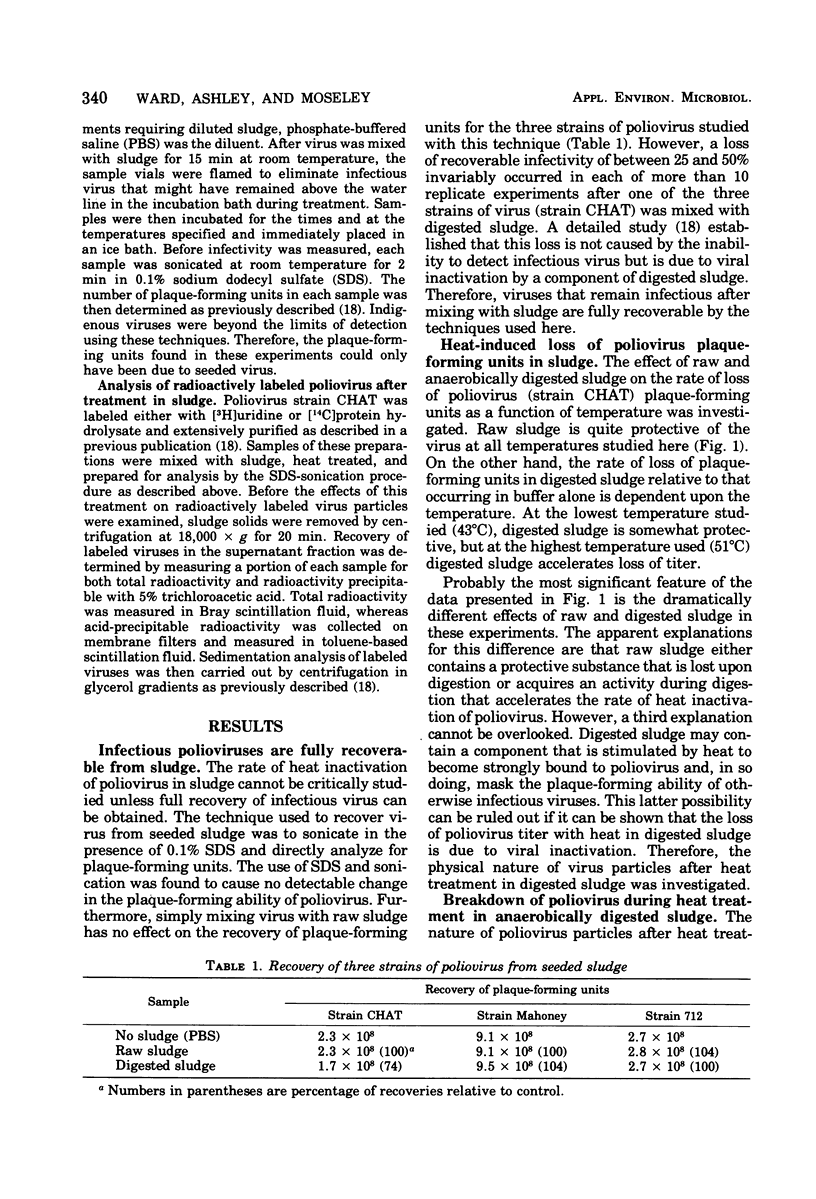
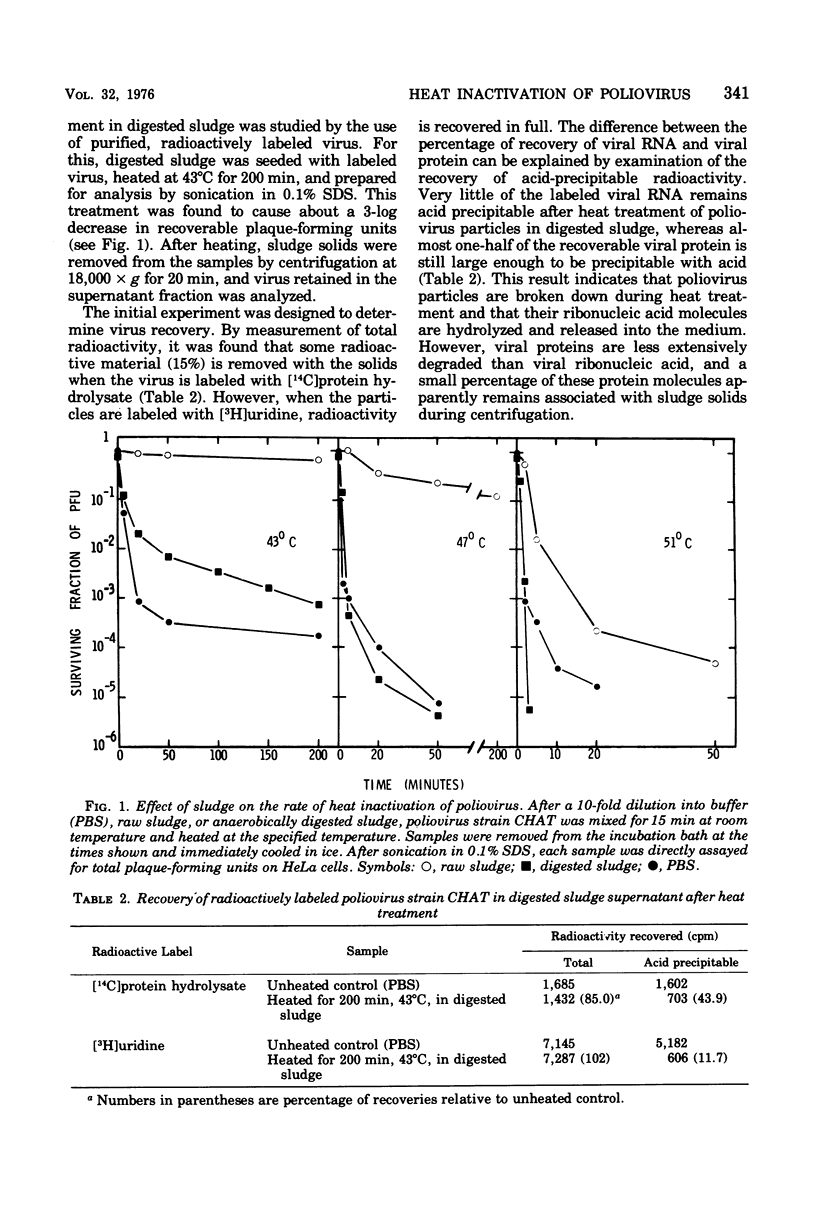


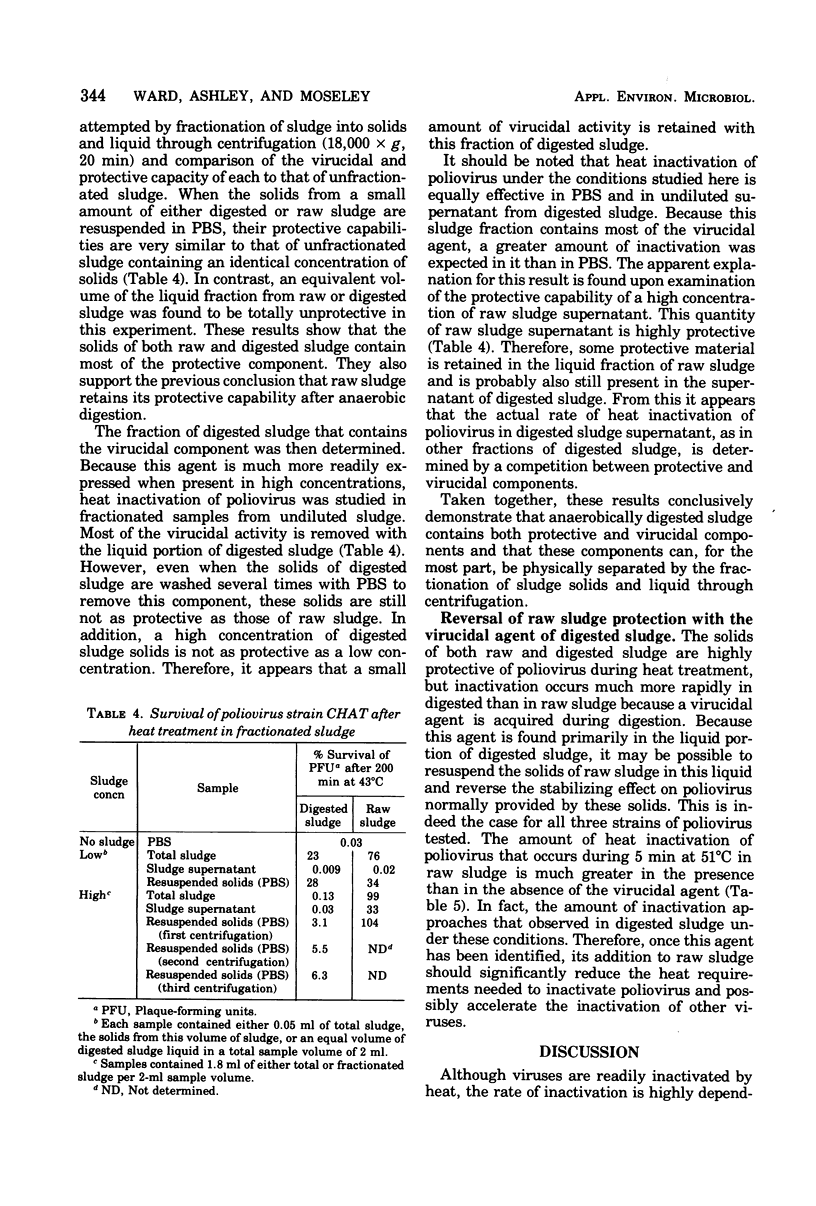
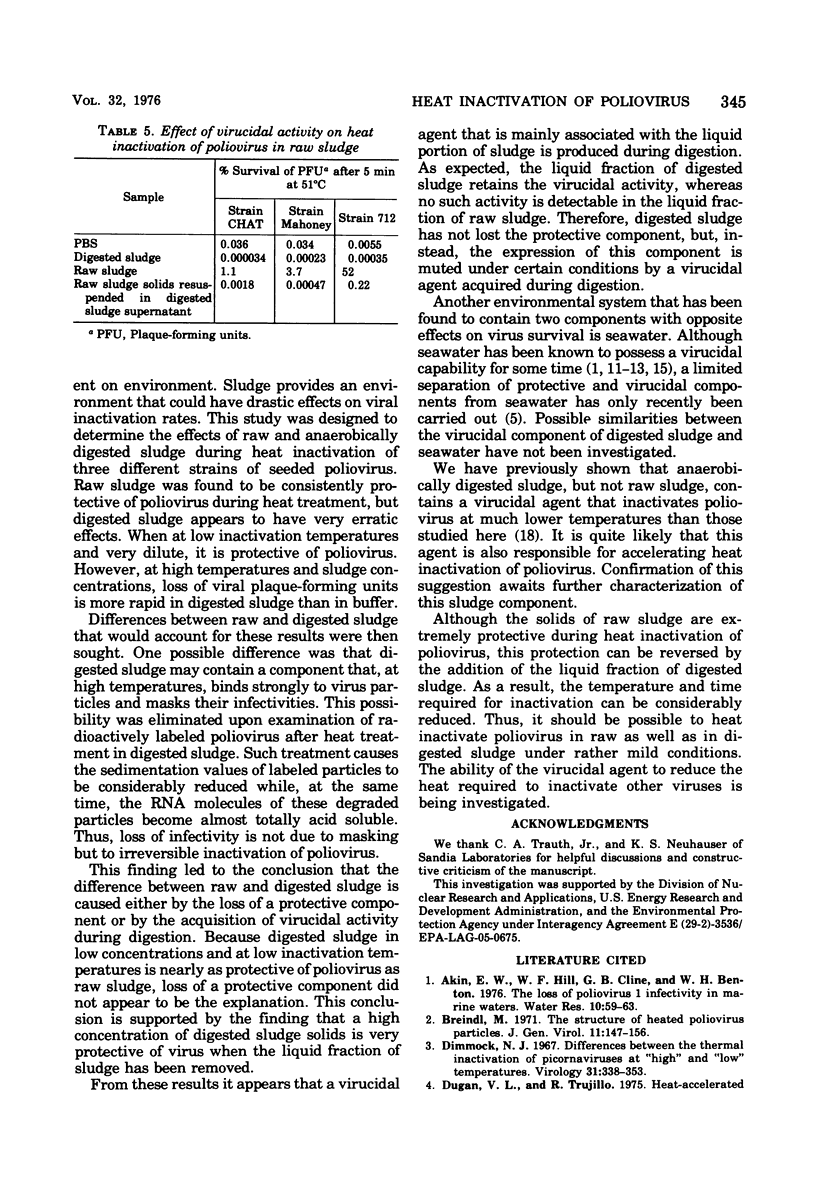
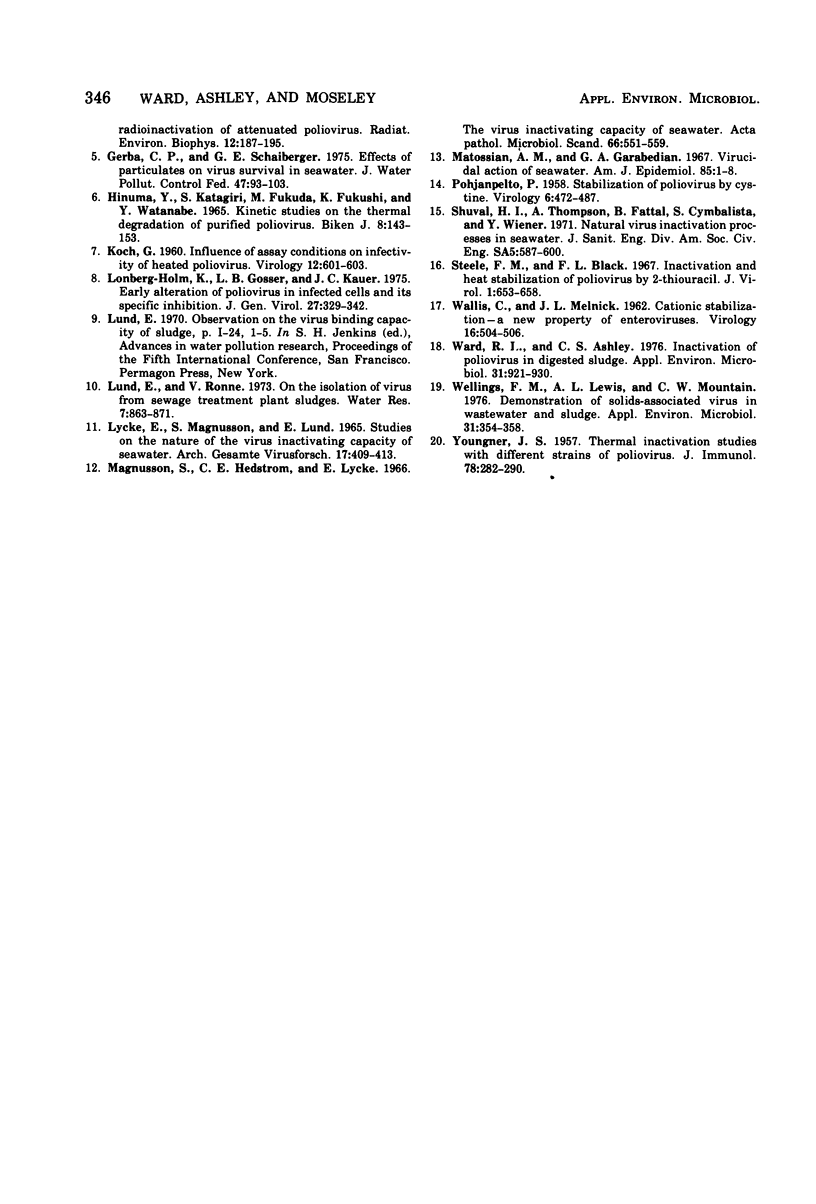
Selected References
These references are in PubMed. This may not be the complete list of references from this article.
- Breindl M. The structure of heated poliovirus particles. J Gen Virol. 1971 Jun;11(3):147–156. doi: 10.1099/0022-1317-11-3-147. [DOI] [PubMed] [Google Scholar]
- Dimmock N. J. Differences between the thermal inactivation of picornaviruses at "high" and "low" temperatures. Virology. 1967 Feb;31(2):338–353. doi: 10.1016/0042-6822(67)90179-1. [DOI] [PubMed] [Google Scholar]
- Dugan V. L., Trujillo R. Heat-accelerated radioinactivation of attenuated poliovirus. Radiat Environ Biophys. 1975 Oct 2;12(3):187–195. doi: 10.1007/BF01327346. [DOI] [PubMed] [Google Scholar]
- Gerba C. P., Schaiberger G. E. Effect of particulates on virus survival in seawater. J Water Pollut Control Fed. 1975 Jan;47(1):93–103. [PubMed] [Google Scholar]
- Hinuma Y., Katagiri S., Fukuda M., Fukushi K., Watanabe Y. Kinetic studies on the thermal degradation of purified poliovirus. Biken J. 1965 Sep;8(3):143–153. [PubMed] [Google Scholar]
- KOCH G. Influence of assay conditions on infectivity of heated poliovirus. Virology. 1960 Dec;12:601–603. doi: 10.1016/0042-6822(60)90183-5. [DOI] [PubMed] [Google Scholar]
- Lonberg-Holm K., Gosser L. B., Kauer J. C. Early alteration of poliovirus in infected cells and its specific inhibition. J Gen Virol. 1975 Jun;27(3):329–342. doi: 10.1099/0022-1317-27-3-329. [DOI] [PubMed] [Google Scholar]
- Lycke E., Magnusson S., Lund E. Studies on the nature of the virus inactivating capacity of sea water. Arch Gesamte Virusforsch. 1965;17(3):409–413. doi: 10.1007/BF01241195. [DOI] [PubMed] [Google Scholar]
- Magnusson S., Hedström C. E., Lycke E. The virus inactivating capacity of sea water. Acta Pathol Microbiol Scand. 1966;66(4):551–559. doi: 10.1111/apm.1966.66.4.551. [DOI] [PubMed] [Google Scholar]
- Matossian A. M., Garabedian G. A. Virucidal action of sea water. Am J Epidemiol. 1967 Jan;85(1):1–8. doi: 10.1093/oxfordjournals.aje.a120666. [DOI] [PubMed] [Google Scholar]
- POHJANPELTO P. Stabilization of poliovirus by cystine. Virology. 1958 Oct;6(2):472–487. doi: 10.1016/0042-6822(58)90095-3. [DOI] [PubMed] [Google Scholar]
- Steele F. M., Black F. L. Inactivation and heat stabilization of poliovirus by 2-thiouracil. J Virol. 1967 Aug;1(4):653–658. doi: 10.1128/jvi.1.4.653-658.1967. [DOI] [PMC free article] [PubMed] [Google Scholar]
- WALLIS C., MENICK J. L. Cationic stabilization--a new property of enteroviruses. Virology. 1962 Apr;16:504–506. doi: 10.1016/0042-6822(62)90234-9. [DOI] [PubMed] [Google Scholar]
- Ward R. L., Ashley C. S. Inactivation of poliovirus in digested sludge. Appl Environ Microbiol. 1976 Jun;31(6):921–930. doi: 10.1128/aem.31.6.921-930.1976. [DOI] [PMC free article] [PubMed] [Google Scholar]
- Wellings F. M., Lewis A. L., Mountain C. W. Demonstration of solids-associated virus in wastewater and sludge. Appl Environ Microbiol. 1976 Mar;31(3):354–358. doi: 10.1128/aem.31.3.354-358.1976. [DOI] [PMC free article] [PubMed] [Google Scholar]
- YOUNGNER J. S. Thermal inactivation studies with different strains of poliovirus. J Immunol. 1957 Apr;78(4):282–290. [PubMed] [Google Scholar]


